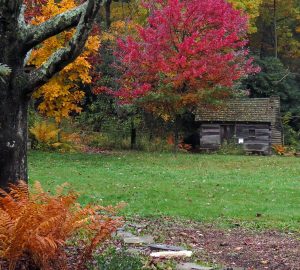
The condemned prisoner could not sleep—for two reasons. The first reason he could not sleep was that it was his last night on earth, and he did not want to waste his final hours in needless slumbers. The next sunrise would be his last. The second reason he could not sleep was that his cell in the Palazzo dell’ Inquisizone was filled with chest-high water. The Tiber River had been flooded for the last twelve hours and he had no place to lie down even if he wanted to. So he stood and waited for the light of his last dawn, listening to the many church bells of the city of Rome.
The bells tolled deeply and solemnly, ringing out over the city of seven hills. During the long night, one bell reminded the Reformer of his native home far, far away. The sound brought back a rush of memories. He remembered his wee home in a Scottish glen near Aberdeen, his father and mother, his brothers and sisters. He remembered his joyful boyhood days, the bluebells and heather that adorned his native hills. He remembered his days at the University at St. Andrews, and his days as a tutor to a noble family. He remembered the day that he had devoted his life to the service of the Church, the day that he yielded his life up to the Dominican Order. He remembered his first journey to the Holy City of Rome, his interview with Cardinal Reginald Pole, and his appointment to the monastery at Bologna.

He remembered especially that fateful day when he had been perusing the well-stocked library at the Dominican monastery in Bologna and his eyes fell upon a forbidden book, written by a Frenchman, titled “The Institutes of the Christian Religion.” With much trepidation, he had opened the pages of this book and had begun to read. That book changed his life. He found in those pages the simple truth of the Gospel, the errors of the papacy, the emptiness of the mass, and the sufficiency of the Savior’s finished work. Soon, he had embraced the doctrines of the Reformation and had begun to speak, first in private and then in public, in favor of the new reform. Some of his brother monks at Bologna had listened. But others had reported him to the Inquisition. He had been quickly tried, defrocked, and sentenced to be burned to death at the stake.
This is what had brought him to Rome, to the Palazzo dell’ Inquisizone. As he stood, reminiscing on his past, he heard a new and growing intensity in the ring of the church bells. No longer were they merely sounding the hours. There was some great occasion, some notable event that had occurred. He waded through the water over to the window and looked out. The lurid glare of flames reflected on the floodwaters of the Tiber, giving the scene an eerie glow. In the distance, he could hear shouts.

Unbeknownst to the imprisoned Reformer, the sitting pope, Paul IV, had died the evening before. Now the people of Rome were in an uproar. Paul IV had been a very unpopular pope. The people of Rome were in the streets giving vent to their joy. They took the marble statue of Pope Paul IV from its place in the Piazza del Campidoglio, gave it a mock trial, dragged it through the streets, and decapitated it before casting it into the Tiber.
The imprisoned Reformer heard the shouts getting nearer and nearer, not knowing what it all meant. As part of the celebration, the people stormed and sacked the Palazzo dell’ Inquisizone. The people of Rome thus released the Reformer on the very day that he would have died a martyr’s death at the stake. Thus freed unexpectedly, he slipped out of the tumultuous city before the fickle crowds could be subdued by the forces of order. The Reformer headed toward the Alps, hoping to make it to Protestant territory before he was overtaken.
The first dramatic event of his flight occurred in the outskirts of Rome. An Italian soldier searching for the escaped prisoners found a group of them in an old abandoned building, resting for the night. Our hero was among them. In the providence of God, this particular soldier had once been in need and had come to the imprisoned Reformer for help. Remembering this kindness, the soldier intentionally ignored the refugees for the sake of our hero.
A few weeks later, on a lonely mountain road in the Italian Alps, an even more remarkable event took place. As the traveler was resting by a pond, wondering how he was to continue his journey without provisions, he was approached by a large black dog. The dog walked deliberately up to the Reformer. The traveler noticed that the dog carried a bag in his mouth. The dog deposited the bag into the Reformer’s hand and walked on, his mission accomplished. As the trembling hands of the Reformer opened the bag, he found that it was a purse full of gold.
The Reformer never saw the dog again. The Jesuits who later heard the incredible story of their enemy’s deliverance claimed that, since the beast was black, the dog must have been the Devil in canine form. The Protestants all united in ascribing the deliverance to the Lord who says, “every beast of the forest is mine.” The Lord who opened the mouth of the donkey, who summoned the ravens to feed Elijah in the dry wadi, who rode the unbroken colt into Jerusalem, is the same Lord who sent the dog to the assistance of His servant.
The Lord of dogs, and men too, had more work for our hero to perform. The Reformer safely crossed the Alps, using the purse of gold to defray expenses along the way. He went to Germany and eventually made his way back to his native Scotland.
He reached Scotland in 1561 just as his native land was openly embracing the Reformed faith. The returning exile was joyfully welcomed by John Knox, who made him his colleague in Edinborough. He was appointed minister at Holyrood Palace and assisted John Knox in opposing the popery of Mary Queen of Scots. During this time, our hero became a great enemy of the Earl of Bothwell. He also served as the assistant to John Knox at the Kirk of St. Giles, standing shoulder to shoulder with Knox for a decade. The author of the Scot’s Worthies said of our hero that he was “a bold opposer of every encroachment made upon the crown and dignity of the Lord Jesus Christ.”
On one occasion, the Earl of Arran, a great enemy of the Reformation, mocked our hero, calling him a “false friar.” Our hero replied calmly, “Mock the servants of God as thou wilt, God will not be mocked, but shall make thee find it in earnest, when thou shall be cast down from the high horse of thy pride, and humbled.” A few short years after this bold prediction, the Earl of Arran was thrown from his horse in battle. His corpse was eaten by dogs and swine before it could be buried. God thus vindicated His faithful servant. For the rest of his long and active life, our hero preached truth, rebuked error, taught children, and wrote a very popular catechism.

The most enduring service ever rendered by our hero was performed in 1580, when he authored a short declaration of the Reformed Faith for the young prince James. It was called “The King’s Confession.” King James lived to repudiate and despise it, but this short and bold document became the core of one of the most important documents in Scottish history, the “National Covenant,” expanded and embraced by the following generation in 1638. Our hero never lived to see the days of the Covenanters, but he was their forerunner, a man loved and honored by the mighty men of his day. Sadly, the name John Craig is today almost entirely forgotten.
In the year 1595, at the ripe age of 83, John Craig heard again the summons of death. It had been many years since he had faced death on the banks of the Tiber River. John Craig had lived to see his native land submit to the Law of God. He had authored the document that would give courage and resolve to a new generation of Reformed Scots. The God that had sent a dog to assist him in the Italian Alps now sent His messenger again, this time not in the form of a black dog but in the resplendent garments of celestial glory, to welcome His servant into eternal rest.
Bibliography
The Scots Worthies by John Howie
The History of the Reformation by J. H. Merle D’Aubigne
The Story of the Scottish Church by Thomas McCrie





Thank you. I came upon your site shortly after i had started to know more about John Craig. I learned of Craig minutes earlier through this: https://wilderreport.substack.com/p/the-hound-of-heavens-scent